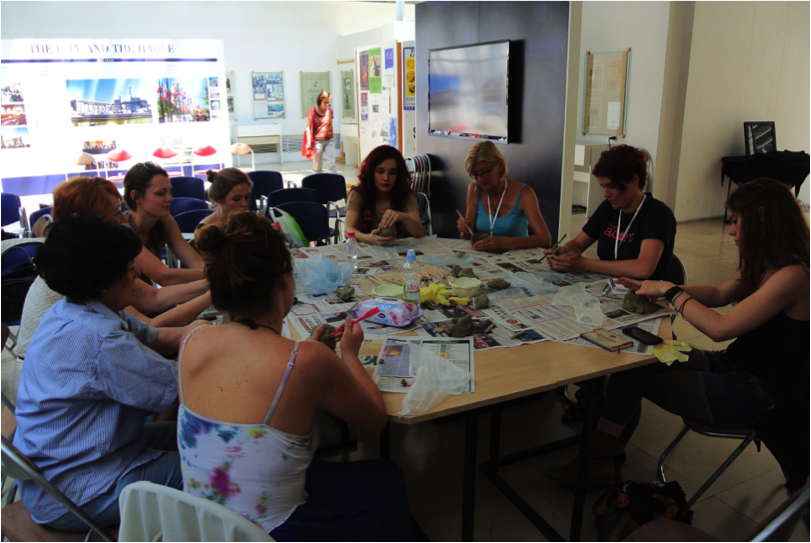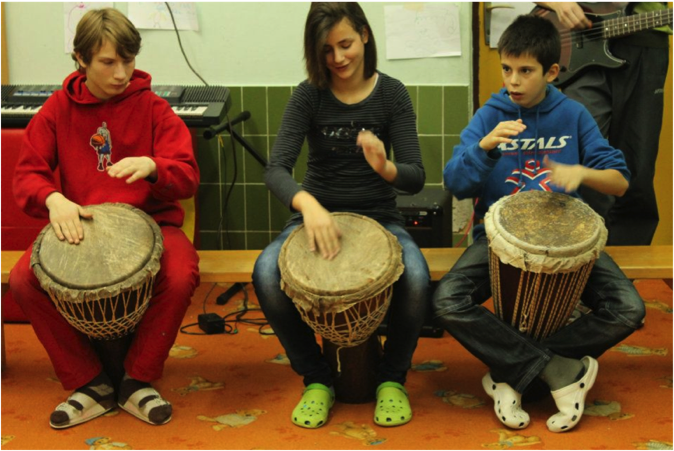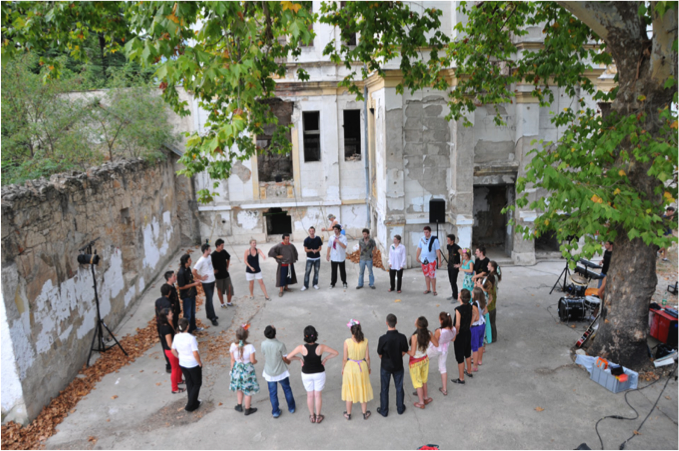
“While art cannot stop a bullet, it can perhaps prevent one from being fired in the first place.” – William Kelley
While art cannot stop a bullet, it can perhaps prevent one from being fired in the first place. – William Kelley
Twenty years on, Bosnia and Herzegovina (BiH) is still suffering the effects of a war that shook the very soul of the country. A myriad of factors hinders the forgiveness process in Bosnia, of which the most commonly perceived are the lack of justice regarding war crimes prosecution, the paucity of reparations and the lack of governmental support for victims of rape and those afflicted by Post Traumatic Stress Disorder (PTSD). Reconciliation and forgiveness can only be achieved through the implementation of approaches that tackle these issues from all sides, but the opportunities for interaction between conflicting groups are few.
One of the key components for creating a sustainable peace for future generations is through the education of young people. The arts are an integral part of the reconstruction of the social infrastructure in post-conflict zones, offering emotional relief and facilitating the communication necessary for reconciliation.
The arts create a neutral space for dialogue and exploration, addressing issues such as collective memory and victimization. Being able to see a story from a different perspective can be the catalyst that sets the process of forgiveness into motion; the feelings of loss and suffering bringing people together instead of setting them apart. The ability to exert control while using artistic mediums is important for victims lost in the chasm that warfare perpetuates. Something as simple as picking up a pencil and beginning to draw can bring relief from psychological suffering.
The arts are a way to foster understanding, communication, and cross-community dialogue as well as the healing of trauma and PTSD. Art therapy is used to help rape victims, war veterans and other individuals with psychological and emotional traumas. It is a way to speak when the trauma is too terrible to be expressed through words.
The use of the arts as a therapeutic practice originates from Shamanism. Art as a means of expression has existed since the Stone Age and variants of such mediums are still used today; for example, the Native American Navaho Medicine men who use sand painting as a healing tool.
Due to Bosnia’s complex political constitution and subsequent geopolitical divisions, the reparations and care for victims with PTSD and emotional trauma is inadequate and unequal. In the Republika Srpska, a survivor must demonstrate 60% damage to his or her body in order to claim reparations; this does not cover or consider the damage to the psyche.
Fortunately, there are individuals, grassroots and non-governmental organizations (NGOs) who are using art to create change, ensuring that this ripple effect of kindness and creativity has the power to transform. One such example is the Sarajevan clay workshop Stories in Clay, run by artist Tatjana Kovačević as part of a reconciliation program that aims to present different stories to participants, which open up a forum for discussion, understanding, and perspective-taking, thereby strengthening interpersonal relations as well as the connection between mind and body. One such workshop was carried out in June 2014 with female participants ranging from 22-60 years of age.
“Clay is an extraordinary medium through which we can express hidden emotion and thoughts. It has a beautiful ability to transform human suffering into joy, bringing a sense of freedom, meaning of life and hope for the future,” says Kovačević. Clay is an extremely effective way of communication as the tactile sense is one of the first to be developed in a human being and is a child’s way of communicating with its surroundings.

“By working with the clay and using various techniques such as hand-building, hollowing and adding, the participants really get to know the clay, redirecting their own feelings of sadness, anger, and frustration into the medium, all of which are hidden beyond our conscience,” notes Kovačević.
The initiative is a way of bringing together women of different ethnic backgrounds, giving them the opportunity for communication in a neutral setting. The clay absorbs emotion and is a malleable medium, allowing the person to create impressions and forms however they choose. “Through different creative tasks, the participants will discover their identity and be able to express themselves as well as communicate and accept the differences in others,” Kovačević explains.

Another example of the use of art as a means for healing is the Music Room project. Three years ago, Sabina Šabić, program manager at the Sarajevo War Theatre (SARTR), started the Music Room project at the Dom Bjelave orphanage in Sarajevo. Inspired by the “El Sistema” project, an initiative in Venezuela offering creative ways out of poverty, Sabina set out “directly making a change through cultural activity.”
“The state doesn’t take care about educational needs, so I felt an urge to get involved and this is my contribution,” says Šabić. The project helps create a sense of social inclusion as the orphanage children are often ostracized from the community and can be bullied at school. The project brings children of different backgrounds and ethnicities together, educating the future generation so that they will learn to live in a harmonious state of social unity.
Workshops focusing on utilizing music as a tool for togetherness and emotional relief are held in the orphanage gymnasium with children of all ages. The instruments are as diverse as the participants, ranging from the didgeridoo to the conga drums. Šabić admits that the project has experienced its rough patches. “It is hard to know what it takes to elicit a smile,” she says. The organization has also suffered from a lack of funding due to a deficit of government backing, but Šabić was able to acquire private funding with the support of friends and colleagues.
The citizens of Sarajevo donated instruments to the project and respecting and caring for these instruments are things that Šabić insists on teaching the children. Caring for property is a transferable skill that encourages sensitivity in other areas of their lives.
“It is beautiful how a project like this can change you,” says Šabić. “Both my mother and sister are psychologists and they help me deal with the emotional aspect of conducting such projects. I dreamt about children every night for a year and it is difficult not to absorb all their different stories.” Šabić’s seven-year-old daughter, Sara, is also involved, treating the orphanage children like an extended family. “She is always celebrating birthdays,” Šabić smiles. Šabić also stresses the importance of including the children and young adults in the decision-making process: “Their voice counts.” The children help write the songs and assist in rehearsals, giving them a sense of responsibility and pride.
The Music Room has hosted artists and groups such as the Sarajevo Philharmonic Orchestra, as well as putting together and producing their own songs for videos. Recently, Al Jazeera Balkans made a short documentary about the project, titled Heroji svakodnevice – Muzička soba (Heroes of Everyday Life – The Music Room).

“I really wanted to bring together all of the amazing and motivated youth that I had met,” states Ashley Fargnoli, dance and movement therapist who worked in the divided city of Mostar for 2 years. In 2011, Fargnoli oversaw a dance project called 3 Notes, which engaged dancers from Belgrade, Mostar, and Sarajevo. “The goal of the 3 Notes project was simple: to foster relationships between youth that normally would not have an opportunity to meet and enable them to share their experiences with one another,” states Fargnoli.
Fargnoli, who collaborated with the United World College in Mostar, GENESIS Dance Company in Sarajevo and the Pavarotti Centre, says, “Dance is a form of non-verbal communication, which can transcend language barriers and boundaries. Dance is a particularly useful medium in integration work where words are sometimes ineffective in resolving issues. The connections and bonds that can be established through dancing together are extremely powerful, helping to bridge misunderstandings and fostering empathy among diverse groups of people.”
“Drama and art is a part of life that is uncorrupted; in the history of the world there wasn’t one war that was started because of it,” says 24-year-old Law student Marko Rozić, who was involved in another community enterprise, Youth Bridge Global’s (YBG) theatrical productions in Mostar.
Professor Andrew Garrod is the co-founder of YBG, an NGO that “uses drama and art to bridge cultural divides, connect youth across cultures and provide educational opportunities.”
“I often find that, in Mostar, children from one side of the Neretva River have never been to the other side,” says Professor Garrod. “Many of them seem to accept the fact that they are taught in classrooms devoid of other ethnicities as a perfectly reasonable way for education to be conducted. I want to shake up these assumptions with my plays, bring kids together so that they can artistically produce something wonderful in which ethnicity has no role.”

Mostar is still very ethnically divided, mostly between Bosnian Muslims and Bosnian Croats. The city saw heavy fighting during the war and the ancient Stari Most Bridge, which to many represented the very soul of the city, was destroyed by Croatian forces in November 1993. The reconciliation process is slow. Children are taught under the so-called “two school under one roof” system, which was implemented to bring children of different ethnic backgrounds together. Ironically, these schools have separate entrances, schedules, and curriculums that separate the children according to ethnicity, making it hard for them to interact socially.
In the summer of 2006, YBG performed Shakespeare’s Romeo and Juliet using a Muslim Romeo and a Croat Juliet. This play was followed by the performance of The Tempest (2011) and As you like It (2012).

“Selecting complex Shakespearean plays allows for detailed analysis of classic literature as well as face-to-face and one-on-one conversations between members of the cast. My aim is to raise the aspirations of the actors and to give them confidence in their voice, in their bodies, and to enhance their appreciation for Shakespeare’s dramatic art,” says Professor Garrod.
Marko Rozić has long since been involved with YBG’s projects. Rozić has participated both as an actor and a production assistant: “The project was a refreshment for us. It was a project that Mostar needed.”
When asked about the ways that dramatic art can bring diverse people together, Rozić stated, “It is fun, and through workshops, we can connect pretty fast. Drinking coffee every day and sharing some special moments with those people created a ‘wall’ around us and we had a world for ourselves — without the borders and limitations we usually face.”

The project has altered Rozić’s outlook and he credits Professor Garrod for “forming these new lives.” The cast was made up of locals and internationals, exposing the youths to a broader perspective. “It really enriches you when you talk to people that come from America and the UK. It makes you realize what life could be like in Bosnia, then you start to question things and realize that you want to help the community.”
“When people are sick of war stories and manipulative politicians, they can turn to creativity. We used Shakespeare’s timeless subjects to send messages of love and absolution. We didn’t just send a message to the audience; we spread it among the cast,” Rozić said.
The attainment of peace is a complex journey and one could argue that it is never fully achieved. What society needs is people along the way who can make this journey easier — to bring joy and faith to everyday life — in the hope that by changing the small things, it will affect those which are out of our control. Reconciliation and forgiveness need approaches from all sides, and community projects such as art, music and drama workshops are a vital part of the healing process.






